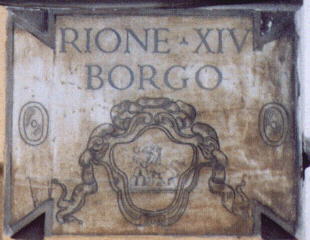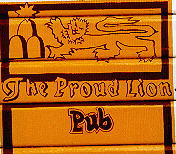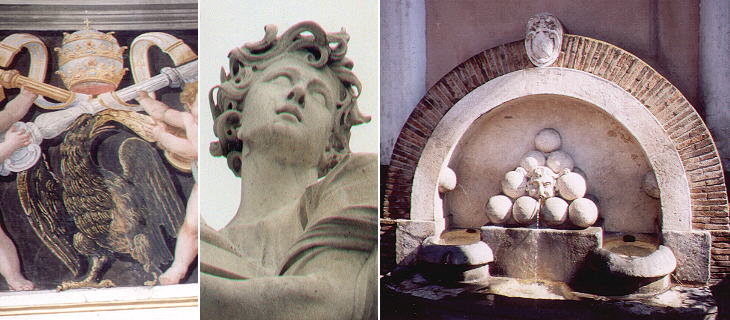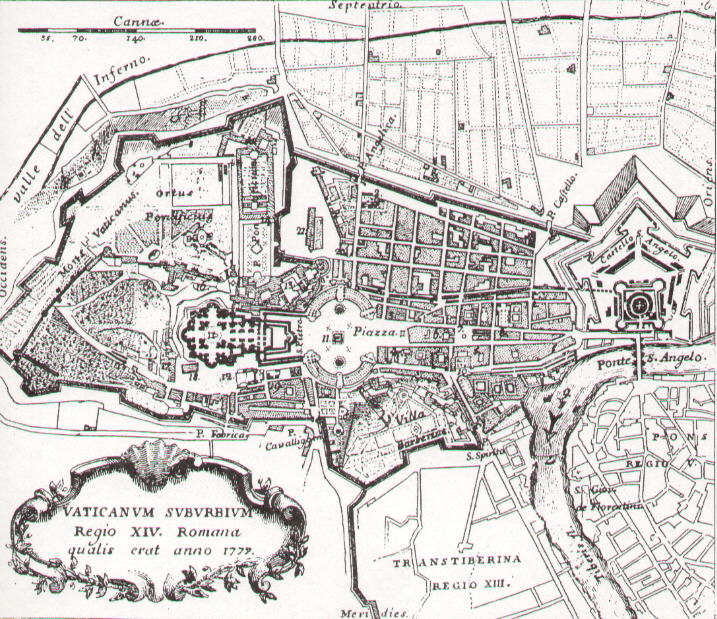  Rione XIV Borgo
Borgo is a corruption of the German word burg (E. borough) which was used to identify the Saxon burg a complex of buildings
(church, hospice, hospital) in the area now occupied by S. Spirito in Sassia: also the streets of this district were called
borgo. The borders of Borgo were first established by pope Leo IV who in 848-52 built walls around the Vatican hill and from there towards the river and
Castel Sant'Angelo. Borgo was then called Cittą Leonina in honour of the pope.
The symbol of Rione Borgo shows a lion, three mountains and a star, all elements of the coat of arms of Sixtus V. It is still popular in the rione and it can be seen even on a pub!
Borgo was outside the city of Rome and therefore Hadrian could build there his Mausoleum (now Castel Sant'Angelo), the most imposing ancient monument of the Rione with the bridge built by the same Emperor. The obelisk now in Piazza S. Pietro was located at the centre of a nearby circus initiated by the emperor Caligola and completed by Nero; another Roman monument (lost) was a tomb similar to Piramide di Caio Cestio and called in the Middle Ages Meta Romuli, as it was thought to be the tomb of the first Roman king. The history of Borgo is to a great extent the history of Basilica di S. Pietro, founded in the IVth century and which soon attracted pilgrims from all over Europe. But of its medieval past Borgo retains very little because in the early XVIth century the popes decided to build a new basilica and in a process which lasted some 150 years they gave to the Rione a Renaissance/Baroque appearance. In addition to the new basilica, the walls, the churches of S. Maria in Transpontina and S. Spirito in Sassia, the papal residences of Palazzo del Belvedere and Casino Pontificio and finally Palazzo Giraud all belong to this period.
Palazzo del Belvedere and the corridors which link it with Palazzo Apostolico, the current residence of the pope, are today known as Vatican Museums, a museum where the building itself with all its frescoes and decorations is an extraordinary work of art. The ecstatic angels of Ponte S. Angelo were meant as a spiritual introduction to S. Pietro. A modern fountain near Porta Castello is a reminder of the military role of Castel Sant'Angelo, the fortress where Clemens VII sought refuge in 1527 and was sieged for seven months.
Legend: 2) S. Maria delle Grazie 3) Palazzo Accoramboni 4) S. Lorenzo in Borgo 5) Palazzo dei Penitenzieri 6) Palazzo dei Convertendi 7) Palazzo Giraud 8) S. Maria in Traspontina 9) Antico Ponte Trionfale 10) S. Spirito in Sassia 11) Obelisco di Piazza S. Pietro 12) Sacrestia di S. Pietro 13) Palazzo Apostolico 14) Palazzi Vaticani 15) Palazzina di Belvedere 16) Fontana del Sacramento 17) Seminario di S. Pietro 18) Palazzo del Cardinale Arciprete 19) Palazzo del Sant'Uffizio 20) S. Anna dei Palafrenieri 21) Fonderia (foundry) del Vaticano 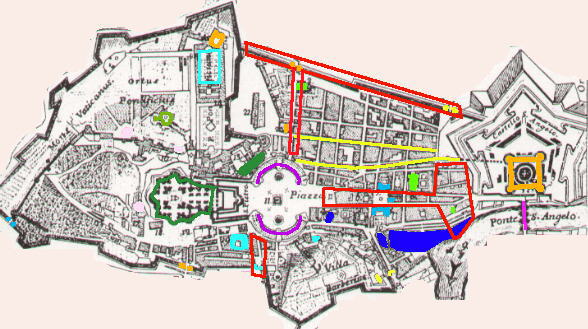
Main monuments of Rione Borgo The areas within the red lines in the map show the major changes which occurred after 1777: a) upper part of the map: the walls from Porta Angelica to Castel Sant'Angelo were pulled down at various moments together with several buildings from Porta Angelica to the walls of Passetto; b) central part of the map: in a process started in the 1930s and completed in 1950 a new large avenue replaced a string of buildings in the heart of Borgo with the loss of S. Giacomo a Scossacavalli; c) lower part of the map: in 1904 the buildings between Colonnato di S. Pietro and Porta Cavalleggeri (included) were pulled down to allow direct access to Borgo from the new quarters of Rome behind the Vatican hill. The different colours group the monuments which are shown in the same page (the list includes a few minor monuments omitted in the map).
You can also have a very close look at it from the Janiculum: Cupola di San Pietro, S. Onofrio, Palazzo del Belvedere, Piazza di S. Pietro, Borgo, S. Spirito in Sassia, Castel Sant'Angelo and S. Giovanni dei Fiorentini.
 or to
The Coats of Arms of the Popes or
to My Home Page on Baroque Rome or to
My Home Page on Rome in the footsteps of an XVIIIth century traveller or to
The Coats of Arms of the Popes or
to My Home Page on Baroque Rome or to
My Home Page on Rome in the footsteps of an XVIIIth century traveller
|
All images © 1999 - 2004 by Roberto Piperno. Write to romapip@quipo.it
